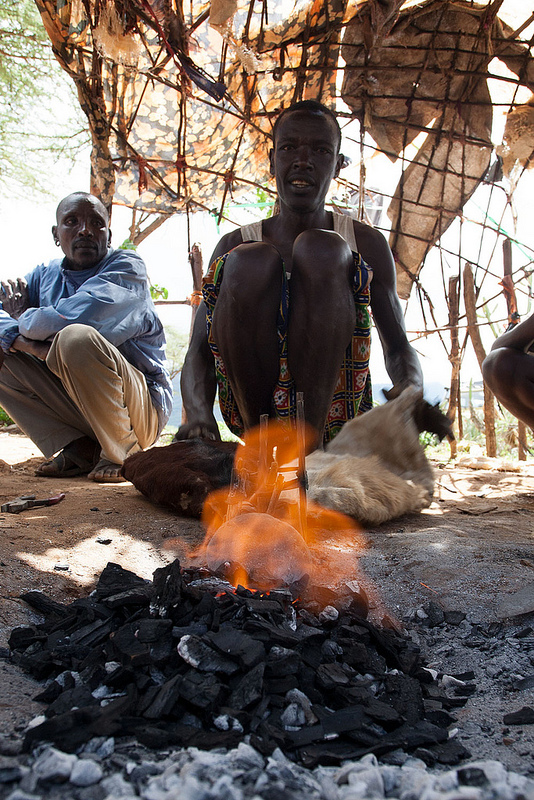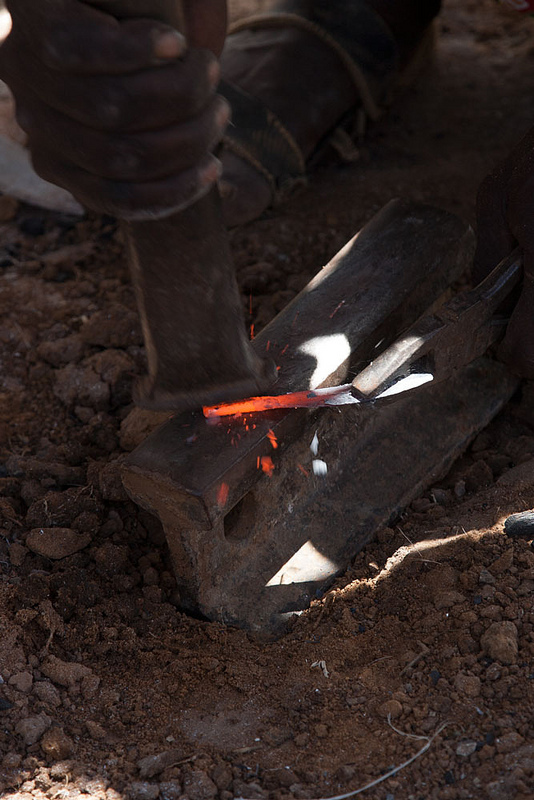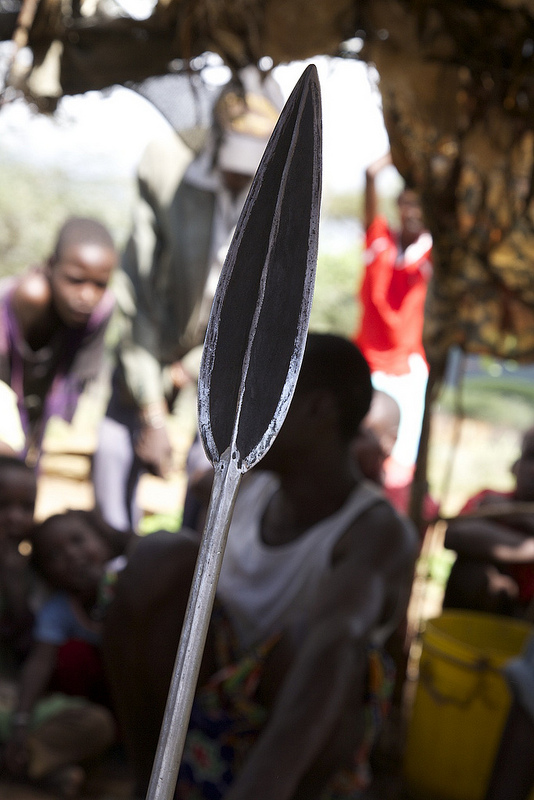We began the next phase of the Maasai cultural heritage assistance project—Fire & Steel: Traditional blacksmithing in pastoral cultures. In November 2013 we spent two weeks traveling in northern Kenya's Samburu country and in northern Tanzania's Lake Eyasi region seeking out blacksmiths who are still creating knives, spears, tools, and jewelry using goatskin bellows and handmade tools. Hope to return in the future for a longer expedition to record at least 5 communities with traditional blacksmiths, researching their techniques and their complex relationships with their pastoral counterparts. These images are from Wamba, in the Samburu region of northern Kenya.
Maasai cultural conservation project: Shield book
Click to see larger imageWe have finalized the print and digital versions of a 112-page book detailing the work of the October 2012 shield-building workshop in southern Kenya. This book is the final visual product we have created for the Maasai community that initiated the cultural conservation program. We are printing 125 copies and are delivering them to the Maasai in November 2013.
Special thanks to all those who contributed to the project. Participants, donors, and those who provided assistance are listed below. Ashe o'leng. Thank you.
Sample pages from the shield book, which is available for purchase on our MagCloud account for $34.95 in beautiful full-color print (bonus: the print version includes a free digital version; shipping is extra) or $9.95 for a digital download (PDF, web version, or iPad app):
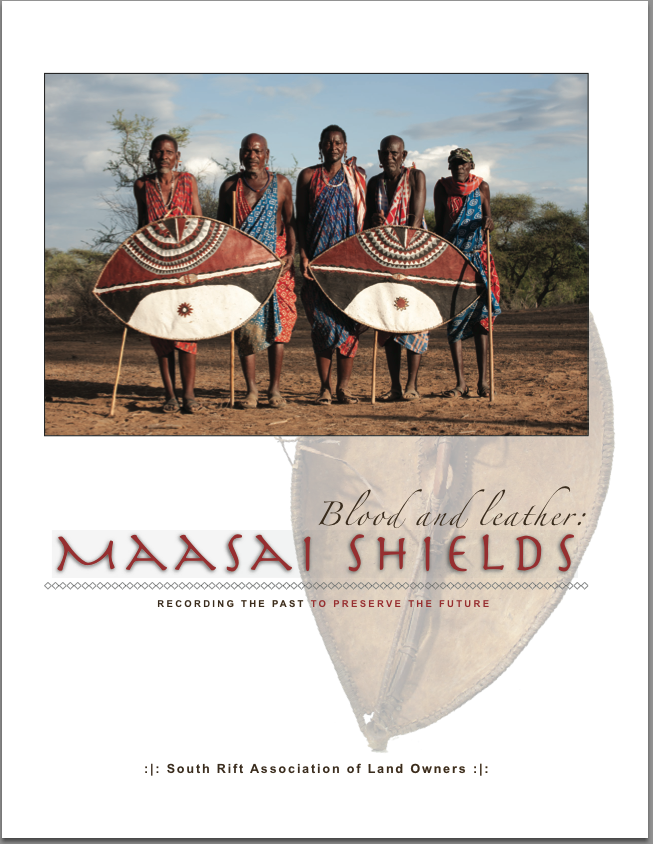
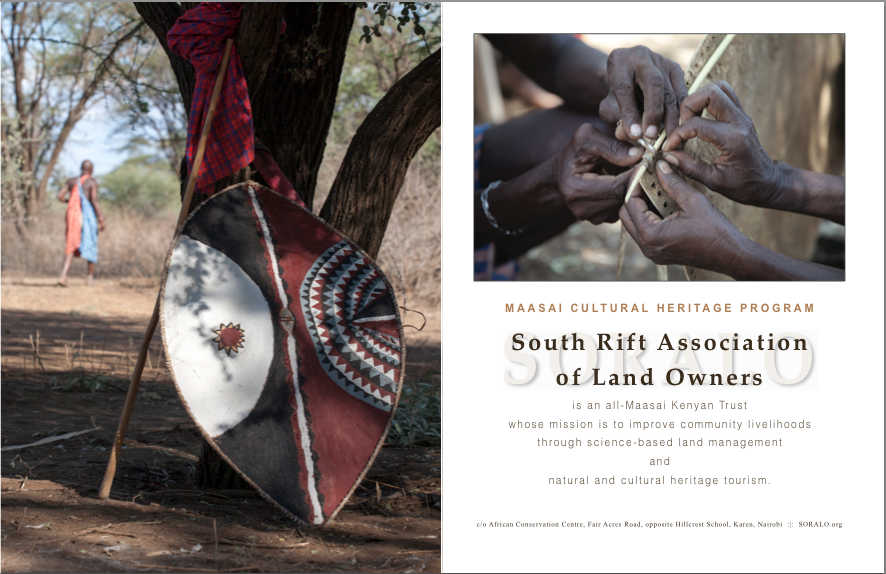
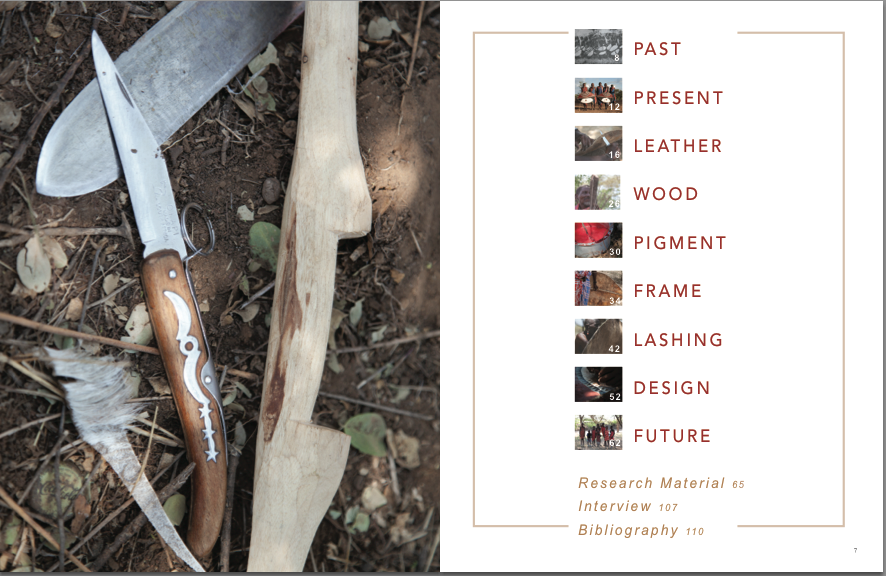
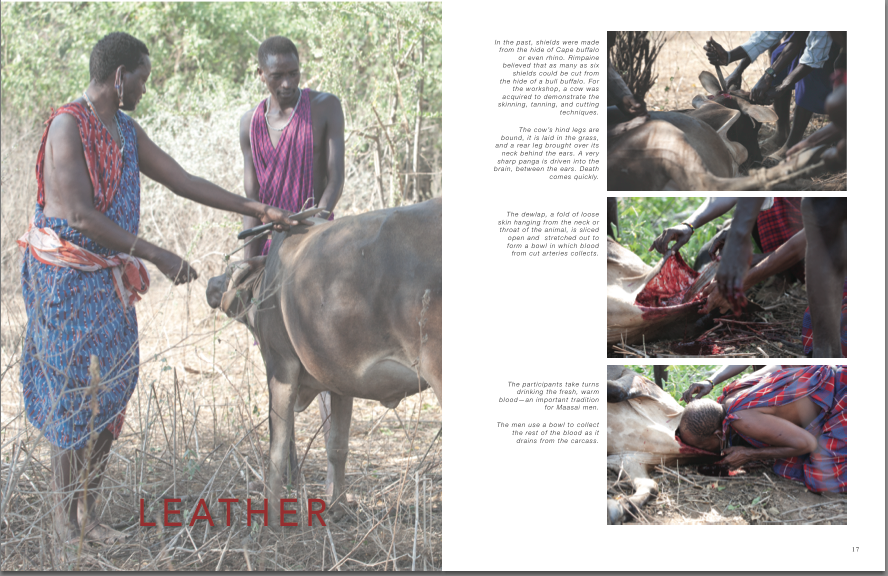

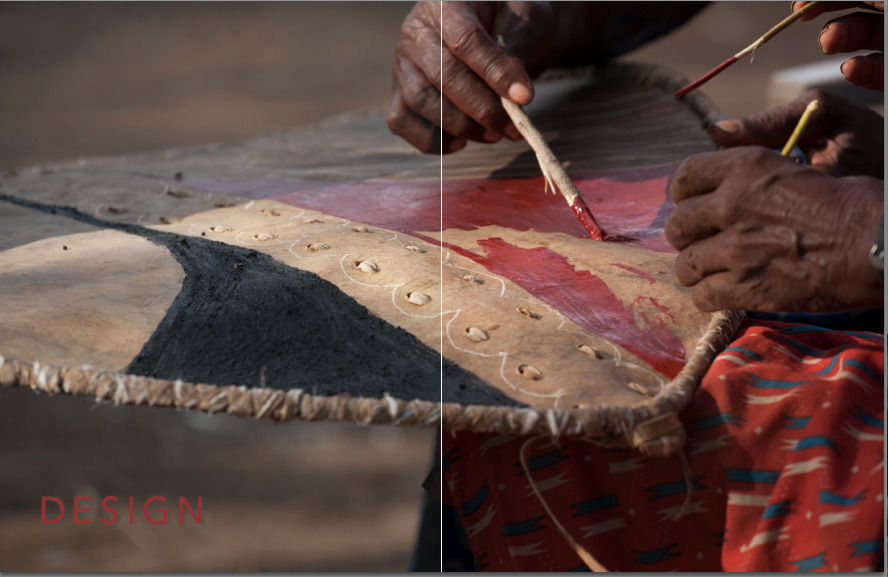
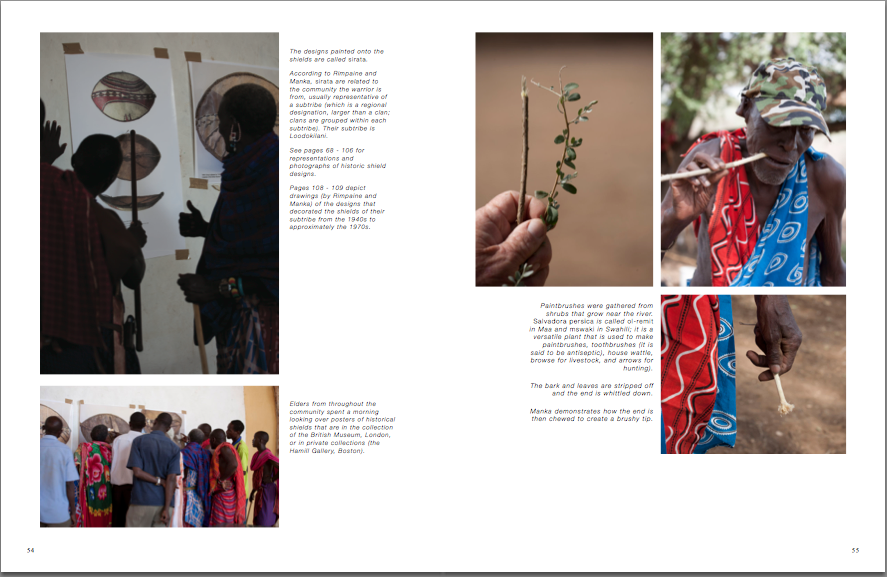
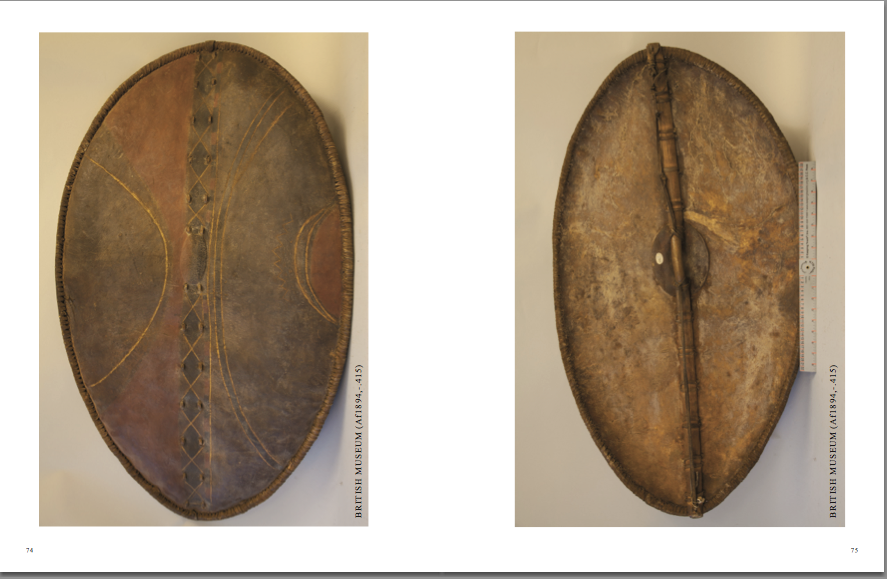
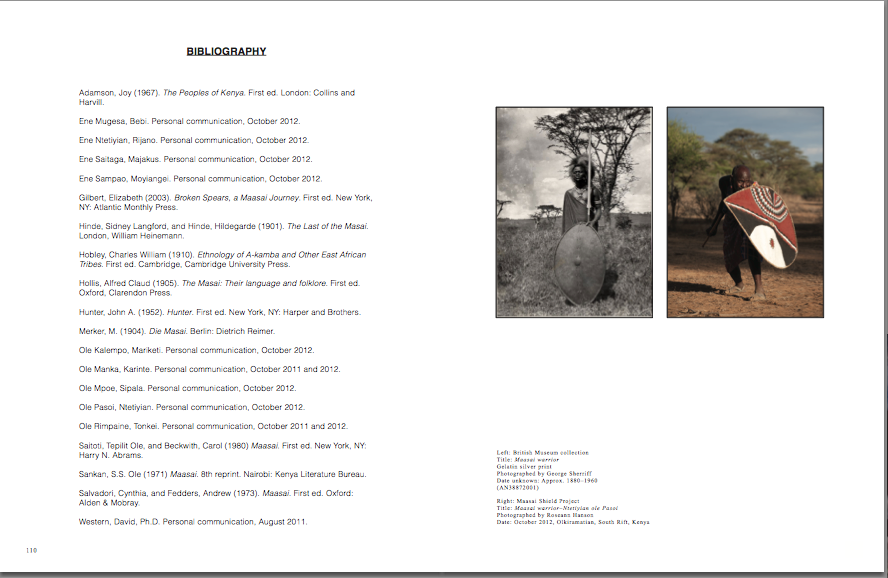
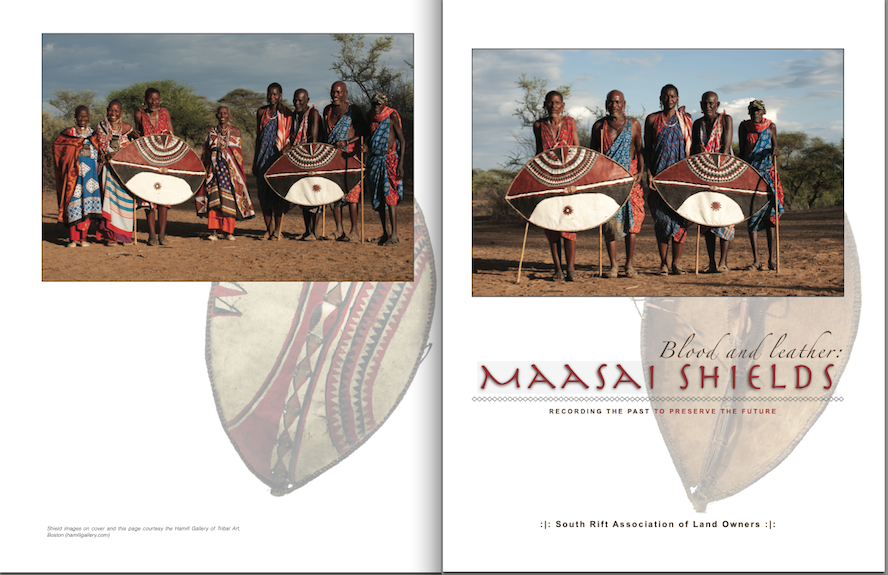
Location: Olkiramatian Community of South Rift, Kenya; Lale'enok Resource Centre
With artisans:
Tonkei ole Rimpaine, Karinte ole Manka, Ntetiyian ole Pasoi, Sipala ole Mpoe, Kelempu ole Ntetiyian, Mariketi ole Kalempo, Rijano ene Ntetiyian, Majakus ene Saitaga, Bebi ene Mugesa, Moyiangei ene Sampao
With assistance from: John Kamanga, project manager; Albert Kuseo, Joel Njonjo, Jackson Kaiseyie, Guy Western
African Conservation Centre, Nairobi, Lucy Wariungi, director, and Dr. David Western, chairman
Elizabeth Loker and Clinton Lucy
Flight & Safaris International, Winnie Akinyi
British Museum, Centre for Anthropology, Catherine Elliott, Jim Hamill, and Christopher Spring
Funding provided by donors of ConserVentures Charitable Organization: Dr. Edward Beggy, Carol Keyser, Doug Mote, Brian DeArmon, R.J. Stappel, Terry & Charlie Beggy, Steve Hayden, Diane Boyer, Tom & Celeste Hanagan, Clay Knight, and with support from OverlandExpo.com.
For more information please visit:
SORALO.org (South Rift Association of Land Owners)
Biodiversity assessment expedition: Sierra Aconchi, Sonora, MX
We produced a short video for Sky Island Alliance's Madrean Archipelago Biodiversity Assessment program to highlight the beauty, diversity, and drama of one of their expeditions.
Trail camera wildlife survey in northern Mexico's Sierra Madre
Mt. lion at Rincón de Guadalupe; click to enlargeCow . . . cow . . . cow . . . two cows . . . cow nose . . . cow tail . . . mountain lion . . . cow . . .
What? Go back.
Six of us were crowded around our little Canon G10, using its LCD screen to review the images from the trail camera fixed securely to a nearby oak tree. Out of several hundred photos, the majority showed either cows, the single squirrel that—unbeknownst to us when we placed the camera—lived in the tree on the left side of the frame and indulged itself in repeated self-portraits, or just apparently empty creekside landscape, the result of wind, an overenthusiastic camera sensor, or invisible extraterrestrials—one is never sure.
But between the cows and aliens the Bushnell Trophy Cam had recorded a fascinating cross-section of the life in this remote canyon in Mexico’s Sierra Madre.
MABA Expedition, July-August 2011
 La Sierra Madre: The Mother Range. It’s fitting that Mexico would give all three of its major mountain ranges the same name, differentiated only by their location—Sierra Madre Occidental, Sierra Madre Oriental, Sierra Madre del Sur. After all, this is a land where devotion to the ideal of the maternal is endemic, where shrines to the Virgin are rarely a stone’s throw apart, and where madres, abuelas, and tias have traditionally ground the corn, dried the carne, and pounded the chile that comprises the life-sustaining triumvirate of Mexican cuisine.
La Sierra Madre: The Mother Range. It’s fitting that Mexico would give all three of its major mountain ranges the same name, differentiated only by their location—Sierra Madre Occidental, Sierra Madre Oriental, Sierra Madre del Sur. After all, this is a land where devotion to the ideal of the maternal is endemic, where shrines to the Virgin are rarely a stone’s throw apart, and where madres, abuelas, and tias have traditionally ground the corn, dried the carne, and pounded the chile that comprises the life-sustaining triumvirate of Mexican cuisine.
 Click to enlargeThe sierras give life to the country too. Peaks ten thousand feet tall scrape rain from clouds spawned in two oceans and two seas, sending it cascading through pine and fir forests where thick-billed parrots screech at stooping goshawks, down through oak woodlands where moonlight fires the eyes of jaguars and ocelots, and out to water the valleys and plains where corn grows, cows graze, and chiles ripen in the sun.
Click to enlargeThe sierras give life to the country too. Peaks ten thousand feet tall scrape rain from clouds spawned in two oceans and two seas, sending it cascading through pine and fir forests where thick-billed parrots screech at stooping goshawks, down through oak woodlands where moonlight fires the eyes of jaguars and ocelots, and out to water the valleys and plains where corn grows, cows graze, and chiles ripen in the sun.
What better goal for a scientific expedition, then, than to explore and celebrate the life in its myriad forms that springs from the Mother Range? That’s the idea behind MABA—the Madrean Archipelago Biodiversity Assessment.
 Click here to download the story in our Terra magazine format, with 16 pages of images, interactive links, and multimedia, or follow the link below to read a simpler version on the website. You can also order a print copy from MagCloud, our HP print partner, here.
Click here to download the story in our Terra magazine format, with 16 pages of images, interactive links, and multimedia, or follow the link below to read a simpler version on the website. You can also order a print copy from MagCloud, our HP print partner, here.
Skills assistance & conservation expedition, Micronesia
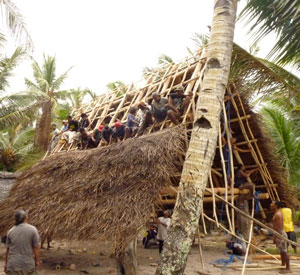 Two ConserVentures board members worked with a community in Micronesia to re-invigorate traditional building and canoe-making skills. With a long history in the community (dating to the 1960s as Peace Corps volunteer), Steve Hayden and Diane Boyer traveled to a small, remote Pacific island to work with the natives who wanted to renew constructing and using waharak (traditional ocean-going outrigger sailing canoes), but lacked funds for and access to tools and sail cloth. The pair delivered adze blades and other hand tools, and 90 yards of sailcloth. The team documented the construction of several canoes and the building of a large uut (thatch-roofed boat house). More documentation coming soon, including video, which is being shared with the community this year. [We are waiting until the communication products have been delivered to the community first, before sharing with the world at large.]
Two ConserVentures board members worked with a community in Micronesia to re-invigorate traditional building and canoe-making skills. With a long history in the community (dating to the 1960s as Peace Corps volunteer), Steve Hayden and Diane Boyer traveled to a small, remote Pacific island to work with the natives who wanted to renew constructing and using waharak (traditional ocean-going outrigger sailing canoes), but lacked funds for and access to tools and sail cloth. The pair delivered adze blades and other hand tools, and 90 yards of sailcloth. The team documented the construction of several canoes and the building of a large uut (thatch-roofed boat house). More documentation coming soon, including video, which is being shared with the community this year. [We are waiting until the communication products have been delivered to the community first, before sharing with the world at large.]
Conservation Expedition: First groundtruthing of South Rift Safari Circuit
 Six ConserVentures volunteers spent 2 weeks in Kenya, the first "tourists" to drive the South Rift Safari Circuit to test the concept for the South Rift Association of Land Owners, also known as SORALO (working in collaboration with African Conservation Fund). Traveling self-contained in rented Land Cruisers and lead by John Kamanga of SORALO, the team explored regions of the South Rift's Maasailand little visited by outsiders. After the trip, the team prepared an extensive report and recommendations for developing the route as a tourist destination (report available upon request to groups or institutions looking to complete similar projects). A magazine story about the trip was also released in an international travel publication. Photo gallery of the expedition, click here.
Six ConserVentures volunteers spent 2 weeks in Kenya, the first "tourists" to drive the South Rift Safari Circuit to test the concept for the South Rift Association of Land Owners, also known as SORALO (working in collaboration with African Conservation Fund). Traveling self-contained in rented Land Cruisers and lead by John Kamanga of SORALO, the team explored regions of the South Rift's Maasailand little visited by outsiders. After the trip, the team prepared an extensive report and recommendations for developing the route as a tourist destination (report available upon request to groups or institutions looking to complete similar projects). A magazine story about the trip was also released in an international travel publication. Photo gallery of the expedition, click here.


